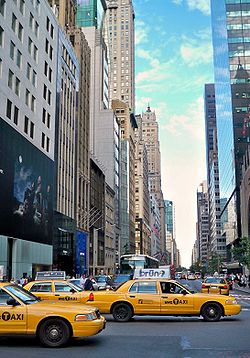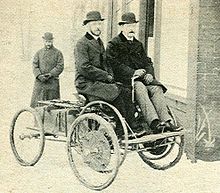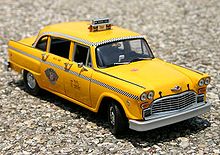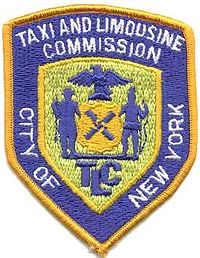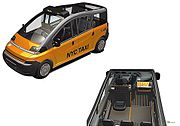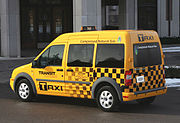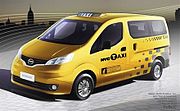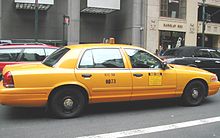- Taxicabs of New York City
-
The taxicabs of New York City, with their distinctive yellow paint, are a widely recognized icon of the city.[1] Taxicabs are operated by private companies and licensed by the New York City Taxi and Limousine Commission. The Commission is a New York City government agency that is best known for its responsibility for the more than 13,237 taxis operating in the city.[2] It also oversees over 40,000 other for-hire vehicles, including "black cars", commuter vans and ambulettes.[1] "Medallion taxis," the familiar yellow cabs, are the only vehicles in the city permitted to pick up passengers in response to a street hail.
History
Late 1890s - The Electric Era
The first taxicab company in New York City was the Electric Carriage and Wagon Company, which began running 12 electric hansom cabs in July 1897.[3] The company ran until 1898 with up to 62 cabs operating until it was reformed by its financiers to form the Electric Vehicle Company.[4] The company then built the Electrobat electric car, and had up to 100 taxicabs running in total by 1899. 1899 also saw a number of notable firsts for the Electric Vehicle Company. On 20 May 1899, Jacob German, driving an electric taxicab received the first speeding ticket in the United States.[5][6] Later that year, on 13 September, Henry Bliss became the first victim of an automotive accident in the United States when he was hit by an electric taxicab as he was helping a friend from a streetcar.[7]
By the early 1900s the Electric Vehicle company was running up to 1,000 electric taxicabs on the streets of New York City until, in January, 1907, a fire destroyed 300 of these vehicles which, in conjunction with the Panic of 1907 caused the company to collapse.
Early 1900s - The Checker Cab
In 1907, following the collapse of the Electric Vehicle Company, horsedrawn cabs once again became a primary means of transport around New York City. In early 1907 Harry N. Allen, incensed after being charged five dollars ($113.66 in 2010) for a journey of 0.75 miles (1.21 km), decided "to start a [taxicab] service in New York and charge so-much per mile." Later that year he imported 65 gasoline-powered cars from France and began the New York Taxicab Company. The cabs were originally painted red and green, but Allen repainted them all yellow to be visible from a distance. By 1908 the New York Taxicab Company was running 700 taxicabs.[3]
Within a decade several more companies opened business and taxicabs began to proliferate. The fare was 50 cents a mile, a rate only affordable to the relatively wealthy.[8]
By the 1920s, industrialists recognized the potential of the taxicab market. Automobile manufacturers like General Motors and the Ford Motor Company began operating fleets. The most successful manufacturer, however, was the Checkered Cab Manufacturing Company. Founded by Morris Markin, Checker Cabs produced the large yellow and black taxis that became one of the most recognizable symbols of mid-20th century urban life. For many years Checker cabs were the most popular taxis in New York City.
1930s - Medallion System Introduced
During the Great Depression New York had as many as 30,000 cab drivers. With more drivers than passengers, cab drivers were working longer hours; additionally, there were concerns regarding the maintenance and mechanical integrity of the vehicles. In considering how to handle the situation, the city considered creating a taxi monopoly. The plan was abandoned after Mayor Jimmy Walker was accused of accepting a bribe from the Parmelee Company, the largest taxi company.
In 1937 Mayor Fiorello H. La Guardia signed the Haas Act, which introduced official taxi licenses and the medallion system that remains in place today.
The law limited the number of licenses to 16,900, but the number dwindled to 11,787, a limit which continued until 1996 when the TLC added 133 cabs.[9] Since then more medallions have been added to the fleet with the current total being 13,237 medallions.[10]
Because the medallion system artificially restricts the number of cabs, it has been criticized as a barrier to entry to the taxi market[11] that has created a market for illegal taxicab operation in areas underserved by medallion cabs. Because the cost of leasing a medallion is so high, the system may cut into the income of drivers and raise costs to passengers. On the other hand, some transportation analysts contend that cities with no barriers to entry to the taxi market end up with an abundance of poorly maintained taxis. They say that a medallion system helps the city to better regulate taxis and enables the city to raise the standards of all taxis.[12]
The medallions which could not be sold for a simple $10 renewal fee during the 1930s are now worth hundreds of thousands of dollars with fleet medallions topping $1,000,000 in 2011.[13] Over the years, many medallions once owned by individual drivers were sold to large taxi fleets. To preserve the opportunity for individual drivers to own and drive their own taxi, certain medallions were designated for owner-operators. These cabs must be personally driven by the medallion owner for 210 nine-hour shifts per year, after which they can, if the driver chooses, be leased out. Corporate medallions, on the other hand, cost more, and are required to be leased double shifts, 365 days a year. About 29% of all taxis are owner operated, the rest are leased.
1960s - Yellow Cabs
In the 1960s New York City experienced many of the problems of social unrest that engulfed other American cities. Crime rates increased along with racial tensions. As a result, a quickly growing industry of private livery services emerged.[citation needed] Unofficial drivers were barred from picking up people on the street, but they readily found business in under-served neighborhoods.
In 1967, New York City ordered all "medallion taxis" be painted yellow to help cut down on unofficial drivers and make official taxicabs more readily recognizable.[8] The wife of the president of New Departure, Nettie Rockwell, particularly liked the color yellow and it therefore became the color of the new Rockwell taxicabs. The Rockwell Service Cab became the Yellow Taxicab when Mrs. Rockwell selected that as her choice of color for the auto.[8]
Taxi Security
One in four new Checkers bought were "partition equipped." Taxi partitions were still optional until September 1968. According to the New York Times (Saturday, August 17, 1968, page 37): "Taxi Partitions - The Checker Motors Corporation, Kalamazoo, Mich., received a patent this week for its Safe-Guard Cab, which has a robbery preventing partition between the front and back seats. According to Checker - the partition makes Checkers which are equipped with the 'Life Guard' partition, the 'second generation' of 'crime stopping' taxis." Crime can be abated, but never stopped. Partitions made knives less viable and made guns more viable. The Taxi & Limousine Commission in NYC has been accused of altering and fudging statistics and facts concerning taxi partition-mandate viability since its inception.
The fleet owners weren't sure of the cause for the decline (in cab driver assaults). One possible reason cited was the increase during the year of the number of policemen who drove taxis during their off hours to supplement their income.
As many as 4,000 cops had been authorized and licensed as taxi drivers starting in September 1967.
The installation of partitions in some taxis has been mandatory since September 1968. Taxis owned by individuals, about 4,600 cabs, were not required to install partitions. That number grew through the 70s and 80s as fleet owners divided large fleets into mini-fleets for two reasons: to avoid the partition mandate, and to limit corporate liability.
Fleet owners felt that, without partitions, drivers would be less inclined to rent cabs at night.
The NYC T&LC enjoys how the partition mandate abates media pressure on their agency about slain cab drivers. Many cab regulators worldwide have considered partition installation mandates for their cities' cabs. Most often the idea is postponed or dropped. Some have adopted the rule and abandoned it later.
Some, like NYC, have enlarged the mandatory market to include more and more taxis, and then all livery cars (or Town Cars), while at the same time, begrudgingly, shrunk the market for partition purchases for use in the "medallion" taxis, because newer vehicle models have side-impact airbags which cannot deploy properly with a partition installed.
The TLC is reported to have plans to soon "crash test" the 'TLC-chosen' vehicle (Nissan NV200) with a partition installed. No crash testing of a NYC taxi partition has ever been conducted before.
Since side curtain airbags became mandatory 'standard equipment' in all US sold cars, a conflict has arisen. Since all side curtain airbags are contiguous from the "A" pillar to the "C" pillar, there is a deployment zone intrusion conflict, when there is a partition installed. This deployment zone conflict has been addressed by the TLC with a requirement for a six inch gap where the partition would ordinarily extend to the "C" pillar - to make space for the airbag deployment. It has been suggested that the partition should incorporate an integral airbag of its own, in the padding, to take the place of side curtain airbags, where partitions are used. This would require the end user to find a way to properly disable the side curtain airbag.
There have been several trauma surgeons who have raised the alarm about occupants slamming into partition metal covering the padding on the back of the front seat, coin trays and window edges. All of the major motor vehicle manufacturers have notified the TLC that mandated modifications such as meter placement and partition installation might, or does, void the car makers' claim of "compliance" with federal standards.
1970s - New York City Taxi and Limousine Commission
The New York City Taxi and Limousine Commission (TLC) was established in 1971 with jurisdiction over the city's medallion (yellow) taxicabs, livery cabs, "black cars", commuter vans, paratransit vehicles (ambulettes) and some luxury limousines. The TLC was founded to deal with the growing number of drivers and to address issues important to both the taxi and livery industries. Its predecessor was the New York City Hack Bureau, operated under the aegis of the New York City Police Department. TLC Inspectors are New York State peace officers who carry batons, pepper spray, and handcuffs.
In the 1970s and 1980s both the unofficial livery services and the medallion taxicab companies began finding more and more of their drivers in the growing populations of black, Latino, and middle eastern immigrants to the city as the previous generation of cabbies retired and moved out of the city.[citation needed] Crime in New York City had become severe at this point, and cabbies were often the victims of robberies and street crime.[citation needed]
Taxi partitions, alleged—incorrectly, by the TLC—to be bulletproof, had proven by October 1970 to be a considerable occupant interior impact hazard, in addition to failing to adequately protect cab drivers from assailants willing to use guns. In the first nine months of 1970, seven cab drivers were killed and 3,000 were robbed in NYC.[14] The response from NYC and Boston taxi regulators was to contend that "continued violent crime against cab drivers" (despite partition mandates) merited a new and innovative "lock-box" requirement. The lock-box requirement was abandoned, quietly, after it was realized that now cab robbers were taking the whole cab. This proved to be too costly so the lock-box requirement was dropped. In response to complaints about head injuries from impact with the partition, the TLC instituted a requirement for a "Talking Taxi Box". This was also abandoned after an eight year trial. It annoyed almost everybody who heard it and it certainly annoyed all drivers who had to hear the static announcements 30 - 50 times a day.
1980s - Demographic change in drivers
By the mid-1980s and into the 1990s the demographic changes among cabbies began to accelerate as new waves of immigrants arrived in New York. Today, according to the 2000 U.S. Census, of the 62,000 cabbies in New York 82 percent are foreign born: 23 percent are from the Caribbean (the Dominican Republic and Haiti), and 30 percent from South Asia (India, and Pakistan).[15][16]
The production of the famous Checker Cab had stopped and although there were still many in operation, the Chevrolet Caprice and Ford Crown Victoria became the industry top choices. Large frame, rear-wheel drive, former police cruisers, available at auctions provide a steady supply of used, well-maintained cars for cab fleets nationwide.
The working conditions of cabbies have changed as crime in New York has plummeted, while the cost of medallions has increased. Fewer cabbies own their taxicabs than in previous times. The TLC bureaucracy involved makes single-cab and small-fleet operations less attractive.[citation needed]
1990s - Changes in types of vehicles and Operation Refusal
In 1996, when Chevrolet stopped making the Caprice, the Ford Crown Victoria became the most widely used sedan for yellow cabs in New York. In addition, yellow cab operators also use the Honda Odyssey, Isuzu Oasis, Chevrolet Venture, Ford Freestar, and Toyota Sienna minivans which offer increased passenger room. The distinctive Checker cabs were, due to their durable construction, phased out slowly, the last one being retired in July 1999, being over 20 years in service and nearly one million miles on its odometer.[17] Laws since 1996 require taxis be replaced every 6 years regardless of condition.
In 1996 the TLC began Operation Refusal, an undercover sting operation created to address the alleged phenomenon of the service refusal. In 1998, the TLC enacted a package, inspired by Mayor Rudy Giuliani, of regulatory reforms that included a structured framework of enhanced driver standards. In 1999, actor Danny Glover filed a complaint with the TLC after he was allegedly refused service by New York cab drivers.[18] This resulted in a highly publicized Operation Refusal crackdown on drivers who were allegedly discriminating against certain passengers, sometimes for race, but far more often because of the passenger's destination.[19]
However, Giuliani's crackdowns led to a series of successful lawsuits against the city and the TLC.[20] In 2000, a federal judge ruled that the NYPD had violated taxi drivers' First Amendment rights by refusing to let the drivers engage in a peaceful protest of new rules. The TLC also lost a series of cases in state courts for implementing rules without allowing for notice and comment. In 2000, another federal judge ruled that the Operation Refusal sting violated the cabbies' due process rights. In 2004, TLC inspectors were embarrassed when they handcuffed and arrested 60 Minutes reporter Mike Wallace, charging him with disorderly conduct for simply questioning the treatment of his driver. In 2006, the city was forced to settle the remaining aspects of the Operation Refusal case. Under the settlement, the TLC agreed to pay a group of 500 taxi drivers $7 million.[21]
Many cabdrivers protested the new regulations sought by the Giuliani administration and in 1998 their activity formed the basis of a new taxidrivers' union, the New York Taxi Workers Alliance. Under the leadership of Bhairavi Desai, the union has grown to fifteen thousand members (2011 estimate), representing almost a third of all licensed cabdrivers in the city.[22]
2000s - New computer technologies, hybrid vehicles, and diesel vehicles
In 2005, New York introduced incentives to replace its current yellow cabs with electric hybrid vehicles such as the Toyota Prius and Ford Escape Hybrid.[23] In May 2007, New York City Mayor Michael Bloomberg proposed a five-year plan to switch New York City's taxicabs to more fuel-efficient hybrid vehicles as part of an agenda for New York City to reduce greenhouse gas emissions. However, the plan was dropped after Cab companies complained that the cost of maintaining the new hybrid vehicles vastly outweighed the tiny amount of fuel savings they got from going smaller. A bumpier ride and a more cramped cabin were also noted as negatives by passengers.[24] Not only that, but passenger safety also became an issue with the newer vehicles, and 6 months after the program took effect, it was dropped. Still, the proportion of the taxi fleet made up of Ford Crown Victorias has dropped over time. It now stands at approximately 60%.[24]
From September to December 2007, many of the taxis participated in a voluntary public art project called Garden in Transit in which flower decals painted by children were affixed to the hoods of taxis.
The TLC has mandated that by the end of January 2008 all taxis should be equipped with a Passenger Information Monitor (PIM) that is a screen in the backseat that can provide entertainment, a live GPS map of location, and be used to pay for rides by swiping a credit card. The drivers will have an electronic Driver Information Monitor (DIM) in which messages can be sent to them informing them of traffic conditions and facilitating retrieving lost objects.[25]
Several taxicab drivers objecting to the cost of the devices (estimated at between $3,000 and $5,000 each)[25] staged voluntary strikes on September 5 and 6 and October 22 in 2007. The city implemented a “zone pricing” structure during the days and the strikes had minimal impact on the city according to officials.[26]
Originally, before October 2007, NYC Yellow cabs displayed the fare stickers in the front doors and the Words "NYC Taxi" and the medallion number on the back doors. On September 30, 2007, all of the yellow cab decals were redesigned. Now, the cabs are easily identified with the medallion number followed with a checker pattern on the left and right rear fenders, a futuristic fare panel on the rear doors, and a retro "NYC Taxi" logo on the front doors.[27]
As of February 2011 New York City had around 4,300 hybrid taxis, representing almost 33 percent of New York's 13,237 taxis in service, the most in any city in North America.[28][29] By mid 2009 owners began retiring its original hybrid fleet after 300,000 and 350,00 miles per vehicle.[30][31] Two attempts by the Bloomberg Administration to implement policies to force the replacement of all New York's 13,000 taxis for hybrids by 2012 were blocked by court rulings,[32][33][34] and on February 28, 2011, the United States Supreme Court declined to consider an appeal by the city.[28] The value of a medallion reached $760,000 in September 2009, an increase of 179% over the previous decade.[35] As of 2011 the price of a New York City Taxi medallion has reached a million dollars.
2010s - Taxi of Tomorrow
In 2007, city officials outlined the goals of a project to replace existing Ford Crown Victoria and other taxis by 2014, as that nameplate is slated to be discontinued in 2011.[36] In mid 2011 the TLC was to award an exclusive contract to sell and service taxicabs in New York City for 10 years. Karsan, Nissan, and Ford's bids were the three finalists, and all of their designs were based on small vans rather than sedans.[37][38] The Karsan design was later rejected due to doubts whether the company could "execute the project".[39] In the end, New York Mayor Michael Bloomberg announced the Nissan design as the winner to replace the city's 13,000 yellow cabs, to be phased in over five years starting in 2013.[40]
Finalists For Taxi of Tomorrow In 2011 New York City was sued by United Spinal Association for choosing an inacessible "taxi of tomorrow". The justice department issued a "Statement of Interest", which was sent to the NY Federal District court stating that if the city did not mandate a wheelchair accessible taxi as the "taxi of tomorrow" it would be in violation of the Americans With Disabilites Act. On November 3-5, 2011, at the TLC's public design expo inviting the public to try out parked prototypes, the Taxis For All Campaign mounted a "Roll-In" protest. Under the eye of news media outside the Flatiron Building on Broadway at Fifth Avenue, wheelchair users tried in vain to use the future cabs.[42]
A fully electric version of the Nissan NV2000 may be available by 2017.[43] However to test the concept, Nissan will first sponsor a pilot program with six Nissan Leaf electric cars and their charging stations, that will be deployed to study the use of zero-emission electric vehicles as taxis. The Leafs will be deployed in 2012, one year before the Nissan NV200s taxis are introduced.[44]
Approved taxi models
As of 2011[update], approved models[45] for use as New York City taxis are:
- 2011-Ford Crown Victoria Stretch
- 2011-Ford Fusion
- 2011- Ford Escape
- 2011- Audi Q7 3L TDI
- 2011- Lincoln MKZ
- 2011- Hyundai Sonata
- 2011- Toyota Camry
- 2011- Toyota Prius
- 2011- Toyota Highlander
- 2011- Nissan Altima
- 2011- Volkswagen Jetta S &TDI Sedan
- 2011- Volkswagen Touareg 3.0L TDI
- 2011- Volkswagen Golf 2.5L TDI Sedan
- 2011- Mercedes-Benz E350 Bluetec
- 2011- Mercedes-Benz ML350 Bluetec
- 2011- Toyota Sienna (Wheel Chair Accessible)
- 2011- MV-1 made by VPG (Wheel Chair Accessible)
Medallion taxicabs and livery taxicabs
Only "medallion taxicabs," those painted in distinctive yellow and regulated by the TLC, are permitted to pick up passengers in response to a street hail. The TLC also regulates and licenses for-hire vehicles, known as “car services” or “livery cabs,” which are prohibited from picking up street hails (although this rule is less often enforced in the boroughs outside Manhattan)[46] and are supposed to pick up only those customers who have called the car service's dispatcher and requested a car.
While medallion taxicabs in New York are always yellow, car service vehicles may be any color but yellow, and are usually black. For this reason, these taxi operators are sometimes called “black car” services. Despite the de jure prohibition on picking up passengers who hail on the street, some livery cabs nevertheless do so anyway, often to make extra money. When a livery cab engages in street pick-ups, it becomes known as a "gypsy cab." They are often found in areas not routinely visited by medallion cabs, and authorities tend to turn a blind eye to the practice rather than leave sections of the city without cab service. The use of gypsy cabs is strictly at the rider’s risk, and it is recommended that passengers negotiate a fare with the driver before entering, as the cabs are not equipped with meters, and fares are not regulated by the TLC. The driver also is taking a risk that the passenger will leave without paying.
Medallion taxicabs are named for the official medallion issued by the TLC and attached to a taxi’s hood. The medallion may be purchased from the City at infrequent auctions, or from another medallion owner. Because of their high prices (often over $700,000)[47] medallions (and most cabs) are owned by investment companies and are leased to drivers ("hacks"). An auction was held in 2006 where 308 new medallions were sold. In the 2006 auction, all medallions were designated as either hybrids (254) or handicap accessible (54) taxis. In October 2011, due to the longtime trend in the medallions' supply and demand, auction prices first topped $1 million.
Hailing a medallion taxicab
Yellow cabs are concentrated in the borough of Manhattan, but patrol throughout the five boroughs of New York City and may be hailed with a raised hand or by standing at a taxi stand. A cab's availability is indicated by the lights on the top of the car. When no lights are lit, the cab is occupied by passengers. When just the center light showing the medallion number is lit, the cab is empty and available. When the OFF and DUTY inscriptions to either side of the medallion number are lit, (with the medallion number lit or off) the cab is off duty and not accepting passengers. In Fall 2011, the TLC announced a plan to replace the three-light system with a simple indicator as to whether the taxi is available.
As with livery cabs, there is an additional round amber light mounted on the left side of the trunk, as well as an amber light at the front of the cab, usually hidden from view behind the grille. When activated by the driver, these "trouble lights" blink to summon the police.
A maximum of four passengers may be carried in most cabs, although larger minivans may accommodate five passengers, and one child under seven can sit on an adult’s lap in the back seat if the maximum has been reached.[48] Drivers are required to pick up the first or closest passenger they see, and may not refuse a trip to a destination anywhere within the five boroughs, neighboring Westchester, Nassau, or to Newark Liberty International Airport.[49] The TLC operates undercover anti-discrimination stings to ensure cabbies do not engage in racial profiling or otherwise discriminate against passengers hailing cabs from the street.
Smartphone applications for taxis
There are several smartphone applications designed to help people find, hail, and share cabs in New York City. On March 31, 2010, Sense Networks, Inc. released CabSense. The iPhone/Android phone app uses location data collected from the New York City Taxi and Limousine Commission to predict which corners in New York City are best for finding and hailing a cab at any given hour of any given day of the week. Report A Taxi, launched by Y INTERACT and Elyxor in 2011, allows passengers to comment on their cab ride experiences and to report drivers to the Taxi and Limousine Commission if necessary. Other NYC cab apps include Cash Cab by Capcom Interactive, Inc. and Weels.
Fares
As of June 2006[update], fares begin at $2.50 ($3.00 after 8:00 p.m., and $3.50 during the peak weekday hours of 4:00–8:00 p.m.) and increase based on the distance traveled and time spent in slow traffic (40 cents for each one-fifth of a mile or 60 seconds of no motion or motion under 12 miles an hour). The passenger also has to pay the fare whenever a cab is driven through a toll. The taxi must have an E-ZPass tag, and passengers pay the discounted E-ZPass toll rates.[50] According to an April 2011 study by the Chicago Dispatcher, New York City taxis have a relatively low standard fare, charging an estimated $14.10 for a distance of five miles and five minutes wait time (compared to an estimated $18.48 in West Hollywood, CA and $12.87 in Houston, TX).[51] Taxi drivers are not permitted to use cell phones while transporting passengers, even if they use a hands-free headset, although this is widely ignored by drivers.[52]
In 1999, 241 million passengers rode in New York taxis. The average cab fare in 2000 was $6; passengers paid a total of over $1 billion in fares that year.[8]
See also
References
- ^ a b New York City Taxi and Limousine Commission (2006-03-09). "The State of the NYC Taxi" (PDF). http://www.nyc.gov/html/tlc/downloads/pdf/state_of_taxi.pdf. Retrieved 2007-02-18.
- ^ Moynihan, Colin. "Rival Drivers’ Groups Disagree on Likelihood of Taxi Strike", The New York Times, August 24, 2007. Accessed October 3, 2007. "The two groups, which have been vying for the right to speak for city cabdrivers, were at odds over a decision by the Taxi and Limousine Commission that requires all of the city’s 13,087 medallion taxis to be equipped by the end of January with new technology including a global positioning system, a credit card system and a monitor that provides passengers with an electronic map."
- ^ a b http://www.npr.org/templates/story/story.php?storyId=11804573 Accessed August 16, 2010.
- ^ http://www.earlyelectric.com/carcompanies.html Accessed August 16, 2010.
- ^ http://www.wired.com/science/discoveries/news/2008/05/dayintech_0521 Accessed August 16, 2010.
- ^ Ellis, Edward Robb (2005) [1966]. The Epic of New York City: A Narrative History. New York: Avalon. p. 461. ISBN 978-0-7867-1436-0. http://books.google.com/books?id=ODnnmcciMLgC&pg=PA461. Retrieved 24 October 2011.
- ^ http://www.pbs.org/wnet/taxidreams/history/ Accessed August 16, 2010.
- ^ a b c d PBS and WNET (2001-08). "Taxi Dreams". http://www.pbs.org/wnet/taxidreams/history/index.html. Retrieved 2007-02-18.
- ^ Medallion Limits Stem From the 30's – New York Times – May 11, 1996
- ^ nyc.gov – Retrieved November 9, 2010
- ^ Regulation Magazine, Vol. 20 No. 1, 1997
- ^ - Schaler Consulting Report
- ^ 2 Taxi Medallions Sell for $1 Million Each - NYTimes.com 705G for cab medallions October 20, 2011
- ^ NY Times Oct. 4, 1970
- ^ Bebepe, Jen. Turning yellow cabs into gold: Long days behind the wheel pay off as drivers become property owners", The Real Deal, September 2007. Accessed October 3, 2007. "In 2000, Bangladesh replaced Pakistan as the No. 1 country of origin for newly licensed cab drivers; some 18 percent of drivers were from the South Asian country, compared to 10 percent in 1991, and 1 percent in 1984. In all, 91 percent of New York City cabbies are foreign-born."
- ^ "The Changing Face of Taxi and Limousine Drivers", Schaller Consulting. Accessed October 3, 2007.
- ^ Wilgoren, Jodi. "Last New York Checker Turns Off Its Meter for Good", The New York Times, July 27, 1999. Accessed August 20, 2008. "The Taxi and Limousine Commission says his Checker, which is on its third engine and nearing one million miles on the odometer, needs a new chassis. Mr. Johnson's mechanic says that would cost $6,000 or more."
- ^ Williams, Monte. " Danny Glover Says Cabbies Discriminated Against Him", The New York Times, November 4, 1999. Accessed October 7, 2007. "The actor Danny Glover, of the Lethal Weapon series, Beloved, and other films, filed a complaint yesterday with the City Taxi and Limousine Commission, charging a cabdriver with discrimination on Oct. 9 for refusing to allow him to ride in the front passenger seat."
- ^ Bumiller, Elisabeth. " Cabbies Who Bypass Blacks Will Lose Cars, Giuliani Says", The New York Times, November 11, 1999. Accessed October 7, 2007. "Mr. Giuliani described the crackdown as a toughening of two existing but only minimally successful undercover efforts, both called Operation Refusal, one run by the Police Department, the other by the Taxi and Limousine Commission."
- ^ Kennedy, Randy (May 1, 2002). "Cabbies Entitled to Hearings, Judge Rules". New York Times, May 1, 2002. http://query.nytimes.com/gst/fullpage.html?res=9E06E4D91431F932A35756C0A9649C8B63. Retrieved April 30, 2010.
- ^ Lueck, Thomas J. "New York City to Pay Settlement to Taxi Drivers Accused of Bias", The New York Times, March 8, 2006. Accessed October 7, 2007. "Under the agreement, termed a "settlement in principle" by Paula Van Meter, a lawyer for the city, about $7 million from the city will go to the cabbies, who were penalized without having been granted hearings for showing bias toward passengers, refusing to take them to certain locations or other violations. The cabbies were penalized by the Taxi and Limousine Commission from late 1999 through early 2002 under Operation Refusal, an enforcement tactic begun after the actor Danny Glover complained that five taxis had refused to stop for him because he is black."
- ^ Widdicombe, Lizzie (April 18, 2011). "Thin Yellow Line". The New Yorker (Condé Nast): 72–77. http://www.newyorker.com/reporting/2011/04/18/110418fa_fact_widdicombe. Retrieved 31 July 2011.
- ^ New York City Taxi and Limousine Commission (2005-09-08). "Taxi and Limousine Commission Votes Today to Authorize Cleaner, Greener Hybrid-Electric Taxicabs". http://www.nyc.gov/html/tlc/html/news/press05_04.shtml. Retrieved 2006-08-16.
- ^ a b No Town Car or Crown Vic? N.Y. Streets Won't be the Same - New York Times - June 25, 2010
- ^ a b Medallion Taxicab Technology Enhancements - nyc.gov – Retrieved November 9, 2007
- ^ City Cabdrivers Strike Again, but Protest Gets Little Notice – New York Times – October 23, 2007
- ^ . New York. http://www.nydailynews.com/news/2007/09/29/2007-09-29.[dead link]
- ^ a b Grynbaum, Michael M. (2011-02-28). "City’s Lengthy Push for Hybrid-Engine Taxicabs Hits a Legal Dead End". New York Times. http://www.nytimes.com/2011/03/01/nyregion/01taxi.html?_r=1&ref=automobiles. Retrieved 2011-03-01.
- ^ William Newman (2009-03-29). "Panel Enacts Incentives for Hybrids in Cab Fleets". New York Times. http://www.nytimes.com/2009/03/27/nyregion/27taxis.html?scp=14&sq=hybrid%20taxis%20new%20york%20city%20-harlem&st=cse. Retrieved 2010-04-14.
- ^ "Ford’s US Hybrid Sales Up 73% for First 9 Months of 2009; Total US Hybrid Sales Down 14% for Same Period". Green Car Congress. 2009-10-14. http://www.greencarcongress.com/2009/10/fords-us-hybrid-sales-up-73-for-first-9-months-of-2009-total-us-hybrid-sales-down-14-for-same-period.html. Retrieved 2009-10-17.
- ^ Fred Gober. "Hybrid taxis slowly catching on in the west". Infotaxi. http://www.infotaxi.org/article_142.htm. Retrieved 2009-10-17.
- ^ Sewell Chan (2008-10-31). "Judge Blocks Hybrid Taxi Requirement". New York Times. http://cityroom.blogs.nytimes.com/2008/10/31/judge-blocks-hybrid-taxi-requirement/#more-4613. Retrieved 2010-04-14.
- ^ Michael M. Grynbaum (2009-09-30). "Federal Bill Would Clear Way for Green Taxi Fleet". New York Times. http://cityroom.blogs.nytimes.com/2009/09/30/federal-bill-would-clear-way-for-green-taxi-fleet/?scp=1&sq=Green%20Taxi%20Act&st=cse. Retrieved 2010-04-14.
- ^ Newman, Andy (2010-07-27). "Appeals Court Rejects Effort to Create Hybrid Taxi Fleet". New York Times. http://cityroom.blogs.nytimes.com/2010/07/27/appeals-court-rejects-effort-to-create-hybrid-taxi-fleet/?emc=eta1. Retrieved 2010-07-31.
- ^ http://www.crainsnewyork.com/article/20091004/SMALLBIZ/310049992/0/information
- ^ Grynbaum, Michael M. (June 25, 2010). "No Town Car or Crown Vic? N.Y. Streets Won't Be the Same". The New York Times. http://www.nytimes.com/2010/06/26/nyregion/26towncar.html?_r=1.
- ^ [1]
- ^ [2]
- ^ Bloomberg.com New York Rejects Karsan Bid to Supply New Taxi Fleet, NYT Says By Ercan Ersoy - May 2, 2011 5:43 AM ET
- ^ Wall Street Journal - New York’s Next Taxi Will Be a Nissan WSJ.com Metropolis section, published May 3, 2011, 11:27 AM ET
- ^ "KARSAN WINS FANS BUT LOSES CONTEST IN NYC". Karsan USA. Karsan Taxi NYC. http://www.karsantaxinyc.com/news/2011/5/24/karsan-wins-fans-but-loses-contest-in-nyc.html. Retrieved 22 July 2011.
- ^ "Taxis For All to Hold Roll-In for Civil Rights at Display of Non-Accessible Taxi of Tomorrow", Nov. 2, 2011
- ^ "New York could see electric taxis in 2017", Gavin Conway, TheChargingPoint.com, May 8, 2011
- ^ Jim Motavalli (2011-05-05). "Nissan LEAF Taxis: Ready for the Mean Streets of New York?". PluginCars.com. http://www.plugincars.com/nissan-leaf-taxis-ready-mean-streets-new-york-107133.html. Retrieved 2011-05-07.
- ^ "Taxicab Vehicles In Use". NYC Taxi & Limousine Commission. http://www.nyc.gov/html/tlc/html/safety_emissions/taxicab_vehicles_in_use.shtml. Retrieved August 29, 2011.
- ^ "Livery Cab Drivers Protest Law by Following Law". New York Press. June 7, 2011. http://www.nypress.com/blog-9095-livery-cab-drivers-protest-law-by-following-law.html. Retrieved June 20, 2011.
- ^ TLC : Average Medallion Prices.
- ^ New York Taxis -- Getting around New York City in a Taxi "New York Taxis - - Getting Around New York City in a Taxi", About.com. Sanction of unrestrained children is contrary to the intent of the child restraint use laws for motor vehicles. Accessed October 2, 2007.
- ^ Taxicab Rider Bill of Rights here, nyc.gov.
- ^ New York City Taxi and Limousine Commission: Passenger Information, Rate of Fare, accessed June 11, 2006.
- ^ http://chicagodispatcher.com/how-does-your-city-fare-p1381-1.htm
- ^ [3]
External links
- NYCTaxifinder a resource for taxi information
- Yellow Cab NYC
- Understanding 2006 Hybrid Car Tax Credits at HowStuffWorks
- New York City Taxi and Limousine Commission
- Article on hossli.com about the designer of the new Taxi logo
- New York City Taxi Driver Oral History Project
- Rear Entry Taxicab Provider
- iTaxiNYC - Taxi information - Lost & Found - Live Traffic - Taxi Reserve - Fare Finder
Wikimedia Foundation. 2010.

